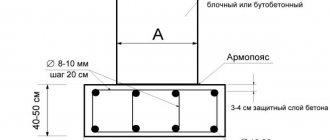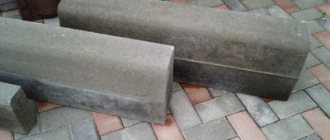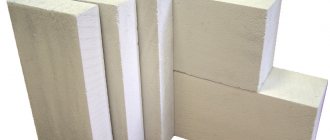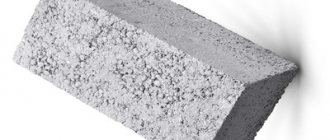The side curb stone is made of high grade concrete. High strength is its main quality. It is used to separate the part of the road where cars move from the pedestrian part, from public transport stops, from lawns, and for decorating flower beds. Borders not only fulfill their functional purpose, but are also used as a decorative element. Therefore, they are painted after installation. Border paint will enhance its durability.
What you need to know about paving slabs
Painting curbs is one of the most common types of road work.
For optimal results, special paints and varnishes should be used. Painting the border in bright colors allows you to solve a whole range of problems. First of all, this operation allows you to effectively differentiate between the roadway and the sidewalk. At the same time, they can better see the dividing line at any time of the day and in difficult weather conditions. Thus, painting curbs significantly increases road safety.
Concrete products, rather than granite stone, are increasingly being used as a delimiter. Their installation is justified from an economic point of view, but they do not have durability.
conclusions
Currently, acrylic paints are most widely used for painting borders for large volumes of work. They make it possible to effectively mechanize painting processes, are affordable and provide high performance characteristics. This solution is suitable for constructing fencing on roads, highways, highways, in urban and industrial environments.
In less critical areas, where the level of negative impacts is not so high (private households, parks, zoos, recreation areas, country clubs, etc.), you can use acrylate paints that have a wider variety of colors, but this will be more expensive . The use of silicone and silicate compounds can provide all the performance characteristics, but this is not justified in terms of costs. In turn, lime coating will be the most budget-friendly, but also the most short-lived.
Technical details of mechanized painting of curbs are visible from the video:
Source
What's it like abroad?
There are many examples showing that whitewashing is the fate of the post-Soviet space. Let's remember:
- the famous Central Park in New York;
- the beautiful Champs Elysees in Paris;
- gardens of Kyoto and Okinawa, full of cherry blossoms.
In none of the listed places are trees whitewashed, and at the same time they look aesthetically pleasing, natural and beautiful. There are thousands of similar examples around the world.
But what about pest control?
To prevent bark beetles from causing any harm to plantings, chemical solutions are used in civilized countries. They are colorless and non-toxic, making them safe for green spaces.
If the damage from parasites is too great, then tree trunks are wrapped with special materials, reliably protecting them and without damaging the structure.
Trees are painted in Africa
This practice exists, but it is the exception rather than the rule. This tradition is observed only in certain tribes, which mark the boundaries of the village in this way.
The important thing is that Africans prepare a painting solution from natural materials that do not harm trees in any way, and it acquires a bluish-blue tint
By law you can't paint trees.
In Russia, there are a number of restrictions prohibiting the painting of trees in the city. Whitewashing is allowed only in places with high sanitary standards. These could be city waste dumps, construction sites or public toilets. Trees near such objects really need protection.
As evidence, one can cite clause 3.1.4.19 of the State Construction Committee of the Russian Federation. Individual cities have a number of their own rules. An example is Chelyabinsk. According to the Resolution of the Head of December 2, 2004 (No. 2200-p), whitewashing is prohibited in parks and squares, as well as on boulevards.
Making a flower bed made of cement
You can decorate a concrete flowerbed by using small pebbles, paint, mosaics, and stencil designs. Here everything will depend on imagination and creativity.
How to paint a concrete flowerbed in the yard
The simplest option for decorating a cement flower garden is painting. For work, compositions intended for concrete surfaces and stone are suitable. The painting process is not complicated:
- Treat the surface from dust.
- Apply two layers of deep penetration primer.
- Paint the flowerbed in the chosen color.
How to make a flowerbed from concrete and fabric with your own hands
Flowerbeds made of concrete, burlap and fabric fit original into the existing landscape design. As for the auxiliary materials, you will need a suitable container such as a plastic bucket; it will serve as the form of a flower bed. The step-by-step process of making a flower bed from a towel and cement is as follows:
- Make a concrete solution of liquid consistency.
- Place the rag into the concrete mass and hold it for a few minutes until it is completely saturated. Hang it on a bucket, which is first recommended to be lubricated with mining or any oil.
- After 48 hours, when the cement is completely dry, the flowerpot should be removed from the bucket and painted in bright colors.
A flowerbed made of cement and rags will have a more interesting appearance if the edges are slightly curved outward.
Drawing and mosaic
You can make a flowerbed out of concrete of any shape - round, square, or diamond-shaped. It is good to use mosaic elements to decorate it. Flower beds decorated with shells, sea pebbles, and fragments of ceramic tiles look very impressive.
First you need to decide on a pattern, then draw its contours on the concrete surface with chalk. Using glue and decorative elements, fill the interior space of the pattern. Upon completion of work, varnish.
Garden decorations
You can improve the area with the help of artificial trees made of sculptural concrete. These decorative hollow products can be represented not only by full-fledged plantings, but also by their individual parts. Stumps, branches, and roots made of cement look beautiful in the garden.
Preparing for work
At the initial stage, material and tools are purchased for applying paint and varnish. When calculating the required amount of paint, it is recommended to take into account the fact that the coating should be applied in at least three layers.
This number of layers will ensure a sufficiently long service life of the protective coating.
Tools
In addition to a sufficient amount of paint, you should prepare:
- metal brush;
- painting tools;
- putty knife;
- containers in which the paint will be diluted. When doing work in the country, you can use old, thoroughly washed buckets;
- primer for concrete;
- special putty for concrete;
- colors.
Removing contaminants
If you are going to paint outdoor paths in the form of tiles, you must remove all the grass between the seams. This can be done using a shovel or any other tool. In this case, it is advisable to remove all plants along with their roots to prevent their germination in the future.
All dust and dirt are removed from the surface of the paths, old paint (if any) is removed with a metal brush, and the base is dedusted. If damage is found on the surface to be painted, for example: potholes, chips, deep scratches, they should be puttied or covered with sealant.
Degreasing
Try to remove all greasy oil stains to prevent them from seeping through the paint layer. This can be done using an orthophosphate solution. You can also use special products designed to remove various types of stains.
Primer
The prepared surface is carefully primed. For work, special deep penetration mixtures are used, intended for application to a concrete base. The primer is applied using a roller or brush in at least two layers.
In this case, you must wait until the previous layer has completely dried before applying the next one. The paint coating can also only be applied after the last layer of primer has completely dried.
Types of border paints
There are different types of border paints, each of which meets specific requirements
It should be noted that the now popular water-based paint can be used for applying to borders, however, you should pay attention to the description of the material, because not all types of “water-based paint” are suitable for painting under certain conditions: for example, some of these paints have low frost resistance
Weatherproof acrylic
Weather-resistant acrylic paint is easy to apply and dries quickly (average drying time is about an hour), providing a matte finish. It is resistant to ultraviolet rays and natural weather conditions. Alkalis, salts and fuels and lubricants do not affect it. When applying, you can use any convenient tools.
To achieve a suitable viscosity, you need to dilute the paint with water. When using, you should choose solvents such as acetone, solvent or butyl acetate. It is best to work with it at temperatures from -5 to +40 degrees Celsius. The range of uses of weatherproof acrylic paint is very wide:
- painting curbs and curbs, highlighting the pedestrian curb;
- creation of road marking strips on highways;
- decorating private areas: for example, in the courtyard of a residential building.
Silicone
The high cost of this group of paints is justified by its good composition and many advantages. They not only do an excellent job when combined with other paints, but also have high strength, permeability and resistance to water.
Limestone
Lime paint can be purchased in two forms: ready-made and paste-like, which must be diluted at the rate of 16 liters of water per 25 kilograms of the composition, constantly stirring the mixture during painting. As a rule, it is applied in white. Features of the paint are antiseptic properties, as well as its vapor permeability. A significant disadvantage of slaked lime is its low resistance to atmospheric and natural phenomena, due to which it is necessary to frequently renew the coating.
For the same reason, this coloring is considered seasonal. Drying occurs within two hours, and before applying lime, the surface must be cleaned and dried, painting at a temperature of at least 5 degrees Celsius.
Silicate and silicate-ash
The materials are applied in two layers to both old and new surfaces: the paint provides a deep matte finish. Paint drying time is 2 hours. Silicate paints are distinguished by their durable coating and wear resistance, as well as resistance to natural phenomena, however, they also have a number of disadvantages.
- It is difficult to remove the old layer to apply a new one.
- The brightness of the material decreases over time.
- The cost of paint is high.
Acrylate
Acrylate stains are used on both new and painted curb surfaces. A new layer of this dye has many advantages.
- Impact resistance.
- Vapor permeability.
- Large selection of shades.
- Resistant to alkali and moisture.
- Temperature range for operation: from -60 to +50 degrees.
Coloring compounds
Paint option for concrete surface.
For painting concrete, special composites are used, made from substances of different chemical compositions:
- oil and latex paints;
- enamels;
- varnishes;
- water-based acrylic and epoxy emulsions.
The difference between the compositions lies in their protective, operational and technical characteristics.
For example, one type of paint is intended only for interior coatings, another is used for exterior and interior surfaces, tolerates low temperatures and exposure to a humid environment, and is not susceptible to mechanical stress.
Therefore, when choosing a composition for treating concrete surfaces, you need to take into account its operating conditions:
- presence of aggressive media (acids, alkalis, etc.);
- ;
- influence of sunlight;
- mechanical loads in wet or dry climates;
- sudden change in temperature.
Staining
The path in summer cottages can be done using an inexpensive material - stain. They use water-based formulations with different types of active substances - acrylic and acid suspensions.
Thanks to this, materials treated with acrylic stains have the following properties:
- vapor permeability;
- durability;
- resistance to any precipitation.
After drying, the color becomes more saturated and resembles the shade of wet stone.
Acid stain is made with the addition of a weak solution of acids. This suspension, unlike classical impregnations, penetrates deeply into the concrete body through a branched system of capillaries, simultaneously entering into a chemical reaction with the components of the material.
The coloring matter, interacting with calcium dioxide, creates solid colored insoluble compounds in the structure of the cement stone. The decorative properties of acid stain allow you to imitate the texture of natural stone.
painted with stain.
Rubber paint
After this substance dries, a durable elastic film is created on the surface of the concrete, protecting the base from the formation of cracks, fungi and mold. The coating has a matte tint, is non-toxic, washes well and has a long service life.
Advantages:
- versatility - suitable for any surface;
- high degree of adhesion - does not peel off, does not delaminate;
- the paint is resistant to ultraviolet radiation and temperature changes;
- waterproof;
- tolerates impact mechanical loads well.
Epoxy and acrylic paints
Epoxy paint is a mixture of mineral fillers and pigments in a liquid resin that gains strength under the influence of special hardeners. It is used to create colored protective and decorative coatings on old or new concrete bases.
Epoxy paint creates a glossy effect.
Performance properties:
- moisture resistance;
- possibility of applying layers of paint on surfaces with humidity up to 15%;
- high mechanical strength;
- abrasion resistance;
- high adhesion;
- does not contain organic solvents.
Paints based on acrylate synthetic resins are resistant to atmospheric influences, temperature changes, are inexpensive and have a long service life (up to 15 years). This is an environmentally friendly product that does not emit toxic substances. The material dries quickly and has no pungent odor.
The aqueous emulsion can be applied to concrete surfaces without the use of complex equipment - with a brush or swab. 1-2 layers are applied at a temperature not lower than +5 °C. Painted surfaces are highly wear-resistant and resistant to short-term exposure to alkalis, acids and chemically active detergents.
Polyurethane varnishes
Film-forming polyurethane compositions are made based on polymers of the urethane group. High mechanical strength and wear resistance are the main features of these materials. They can be applied to concrete surfaces even at an ambient temperature of -30 °C.
Before use, two-component suspensions are combined with a catalyst and applied in a thick layer. The quality of the coating in this case is much higher than as a result of using one-component compositions. The disadvantages of this composition are the impossibility of processing products at low temperatures and the high speed of setting of mixtures - the solution prepared at the construction site must be applied within 1 hour.
Negative consequences of whitewashing
The consequence of insufficient gas exchange is a lack of nutrients in the root system, which leads to its gradual weakening, rot, and ultimately the root collapses into dust.
A massive tree can no longer hold on to such a weak foundation and falls, dragging with it asphalt or paving slabs turned out by the remains of roots.
News about trees falling on citizens or cars is just an illustration of what improper whitewashing in the city leads to. Naturally, the question arises - why are they still doing this?
Secondly, in the 20th century this process was actually justified - during World War II, white tree trunks served as night landmarks for drivers driving with their headlights off to avoid detection by enemies.
In peacetime, this is absolutely useless, moreover, it harms green spaces. People of the older generation have formed the belief that white trees and borders decorate the city and make it brighter and more comfortable.
For housing and communal services workers, this is also an additional item for reporting on the work done.
However, it would be much more effective to revise outdated schemes and direct funds to real improvement of urban infrastructure - road repairs, improvement of children's and sports grounds, parking lots, landscaping, etc.
Coloring option
In bulk
It is considered the most practical and best way. In this case, coloring pigments in powder form, which are used for concrete, are added directly to the gypsum solution. Thus, you receive a product that is painted from the inside.
When cutting or chipping, you will not see the white base.
Painting artificial gypsum stone with coloring pigments
A beige or yellow solution is best, and in polyurethane form, parts of the stones can be painted with liquid pigments using a brush.
- take ½ tsp. color (pigment);
- add 200 ml of water;
- add 200 ml of any acrylic primer.
When the stone has set, remove it from the mold and dry it, and after laying it on the surface, apply a matte water-based varnish to it.
This option for painting decorative gypsum stone is the most effective and almost all manufacturers use it. That’s why we can see these kinds of products in stores. The disadvantage of this method is the rough and unnatural painting, which can be observed at close range.
By making gypsum artificial stone yourself, you have the opportunity to work on naturalness by carefully painting parts of the stones in the mold. Of course, no one will do this on an industrial scale, otherwise the price will increase significantly.
Below we will propose another painting technology that will help make a product from gypsum tiles that is more similar to natural stone. You will learn how to paint artificial stone so that it has the same natural veining and color scheme as natural stone.
Surface
- tinting paste for water-based paints (color pigment);
- water;
- spray or brush.
Tinting paint for artificial stone
The instructions are simple - you need:
- add a coloring pigment to the water, you can even add several at once;
- dip a brush into the solution;
- saturate gypsum tiles with it.
Artificial gypsum stone has unique properties of developing shades that are similar to natural ones due to the absorption of tinted water.
Tip: add 30-50% of the weight of any acrylic-based primer to water to give additional strength to the product after drying.
In order to give gypsum stone the desired shade and color, you do not need to have an artistic education. Dip the brush into the colored water and paint the stone as you see fit.
In the photo - paints for working with plaster
Then you can tint some with a dark solution consisting of color pigment and water. You shouldn’t think too much about the palette, since each gypsum tile, even with the same texture, will absorb the solution differently, which will allow you to create an individual pattern each time.
Advice: using fire-retardant metal paints Polistil in your apartment or house, you can protect the items you need from fire.
- spray gun;
- sprayer for glass cleaning products.
Pour paint diluted with water-based tinting paste into a container and spray it onto the gypsum tiles. How to putty a ceiling with your own hands video for a beginner before painting? It is better to use several of these sprayers with different colors in your work so that you can treat different places on the stone.
Then the painting process will be better and faster.
The advantage of painting yourself
- The store offers artificial stone in standard colors and with obvious artificial coloring. It does not have natural colored veins, like natural ones.
- You can purchase products in white or plain beige, glue them to the walls, and then paint them on the spot with water and coloring pigments diluted in it. This method makes masonry much more natural. (See also the article Types of finishes: options.)
Interior paint for application to plaster
- Once the plaster stone has dried and become faded and pale in appearance, open it with any silky matte or matte varnish. This way you can restore the color saturation of the product, strengthen and protect its surface.
Tip: use water-based varnishes; they have no toxic odor and dry faster.
- If you want to achieve a “wet” effect on artificial stone, use glossy varnishes for painting, but be aware that this will slightly reduce the naturalness of the material.
DIY fence painting
Original painting of the fence allows you to give any wooden fence a stylish look. To work, you will need to prepare a primer, paints, and matte varnish. Painting is carried out in clear, dry weather. Any householder can do the job efficiently.
How to beautifully and unconventionally paint a wooden fence?
To create an unusual design, you will need to first select a bright piece of art. If it is quite difficult for the performer to transfer an image with numerous lines and color transitions, he should opt for a simpler and more beautiful picture. We will look at drawing funny vegetables. To carry out painting work on the fence you will need:
- thick black marker (industrial use);
- fine abrasive sandpaper;
- white primer (can be replaced with another white primer for wood);
- acrylic paints on wood;
- brushes, container for preparing paints;
- Matt lacquer.
A wooden fence is painted on a sunny day and in warm weather. This will allow the compounds to dry quickly, eliminating the risk of them being wiped off or damaged during operation. In total, painting may take 1-2 days, depending on the mixtures chosen. When applying each type of coating, you must take into account the drying time specified by the manufacturer. Before applying each new layer, you should make sure the base is dry.
Preparation for work
If the surface of the boards is smooth and there are no strong nicks, then you can immediately begin painting the fence. If there are protruding chips on the fence, they must be carefully removed and the transition sanded.
Afterwards the performer can begin to apply silhouettes. They should be carefully drawn with an industrial wood marker or a general-purpose marker. After getting wet, it will not give streaks. If the lines are drawn unevenly, do not worry: they can be covered with a primer in the future.
After preparing the silhouettes, you can begin priming the surface. It is recommended to use acrylic white primer. It has increased density and does not transfer all the moisture to the wood; it lays down neatly. It is durable and allows you to slightly smooth out the unevenness of the fence.
Step-by-step instructions for painting a fence
As soon as the white primer is completely dry, you can begin preparing the paints. They should not be applied to a half-damp base. Bright painting of the fence with your own hands is carried out according to the following scheme:
1. Background paints are diluted (if necessary) and applied with a thick brush to the prepared drawings.
2. The frames of the eyes are drawn and painted over with white paint. Smiles and lip silhouettes are painted with black paint.
3. Vegetable leaves (silhouettes) are drawn with black paint and painted with green acrylic.
4. After the compositions have completely dried, the surfaces are lightly sanded with fine abrasive sandpaper. This will increase the adhesion of the materials to the varnish.
5. The drawings are coated with matte varnish.
There are several advantages of using matte varnish: it allows you to make the design brighter and does not affect the change in shades. In some cases, glossy images will look out of place on a wooden fence. After the varnish has dried, additional protection of the picture is carried out: the prepared picture is coated with an antiseptic.
These instructions will help you understand how to paint a fence with minimal time and money. But the performer must strictly follow the rules for selecting compositions and their use. Additionally, you should study the attached photo and video lessons. This will help you understand the nuances of coating application and help you find original ideas.
DIY fence painting video
Impregnation primers, primers
They come on an organic and inorganic basis. Since these are impregnations, they do not form any film on the surface, and therefore cannot peel off or come off. Their components penetrate into concrete and bind molecules with polymer chains. As a result, the strength of the surface becomes 2-3 times stronger, resistance to aggressive environments (acidic and alkaline), temperature changes increases, it tolerates frost better, and the formation of dust is also eliminated.
In general, there are three types of primers for concrete:
- Polyurethane. Their main purpose is waterproofing; they are also used to make repair mortar: the primer is mixed with sand and cracks and chips are repaired with this mixture.
- Water-dispersed. They do a good job of dust removal and slightly strengthen the concrete surface. Their prices are average.
- Epoxy. For the most part, they are two-component, prepared before application, and their main purpose is waterproofing.
After two layers of concrete impregnation, the floor does not generate dust at all
If, after treating with a primer, you will not paint the floor or fill it with any other finishing coating, then water-dispersion primers are best suited for dust removal of garage floors. For paint or other coatings, primers of the same type are used: for polyurethane paint for concrete of the same composition, preparation is used, etc.
Polyurethane (polymer) impregnation for concrete
This garage coating is good for everyone, except for the price - 1 liter costs about $5. You can find packaging of 3 kg and 20 kg. Impregnation consumption when applying the first layer is 0.25-0.5 kg/m2. For the second - 0.15-0.2 kg/m2.
When processing, do not dilute, smear generously, at least twice. Polyurethane impregnation for concrete binds particles without forming a film. Such a concrete floor will stop generating dust and will absorb less liquid. The same compounds are used to strengthen crumbling concrete surfaces. If the process has already gone far, they will not help, but if only traces of abrasion are visible, impregnation will help delay the process.
Application of polyurethane impregnation
Polymer impregnations are applied only to dry surfaces. The moisture content of the concrete should be no more than 5% (at least 28 days must pass from the moment of pouring). The composition is poured onto the floor in portions, spreading with a roller or a special mop over the entire surface. Some companies can add color, so you can get a colored garage floor at the same time. This treatment can be used as a preparation for the subsequent application of paint or polymer floor covering.
Application features: temperature should be from 0°C to 17°C, air humidity not lower than 70%. If the humidity is lower, it must be moistened artificially - with electric humidifiers or by hanging wet rags in the garage, constantly making sure that they do not dry out. Only under such conditions will polymerization be good.
Epoxy primers
This type of impregnation consists of two components that are mixed immediately before use. You can work with them at temperatures above +5°C, there are no other requirements. The cost is higher than polymer ones - $7 per kg, consumption is almost the same.
Benefits of coloring
- Possibility of changing color every few years;
- Unlike pigmentation of concrete mortar, surface painting of a concrete path allows you to obtain a coating of the desired color with a more saturated palette and density;
- The coating protects the concrete from the penetration of water into the pores, thereby extending the service life of the garden sidewalk;
- Application can be done manually in a short time, and walking on the concrete surface is allowed immediately after the paint has dried - from several hours to a day;
- The path can be washed with water; dirt, as a rule, does not eat into the coating formed by the paint layer.
Which one to choose?
When choosing paint for such work, it is recommended that you familiarize yourself with its characteristics before purchasing. Thus, the coloring agent is selected that is resistant to mechanical damage. Because people walk along concrete paths and vehicles move, it is necessary to choose a paint that will be least susceptible to deformation during the day.
An important factor is also considered to be the resistance of the material to ultraviolet radiation, because the scorching rays of the sun can cause the destruction of the coating and the appearance of cracks on it.
Functional purpose of paint
The border is painted in white, black and contrasting colors.
- A painted curb improves driver visibility of road barriers. White paint is most often applied.
- Colored decoration is used in the courtyards of houses and on private property. The dye decorates the stone.
- The CM transfers its qualities (impact resistance, resistance to salts and water, light resistance, resistance to chemicals that are used on roads in winter) to the curb. A durable, high-quality layer appears on the surface of the stone.
The paint is applied in 2 layers, spray, roller or brush. Coloring is possible if the temperature does not drop below -15 o C, almost all year round.
Why are borders whitewashed?
Whitewashing borders is an essential element of landscaping. They are whitewashed for aesthetic reasons to create an atmosphere of celebration and comfort. Whitewashed curbs also help drivers navigate and distinguish the edges of the road in the dark or fog.
Interesting materials:
How to prune blackberries for the winter? How to prune and insulate roses for the winter? How should you prune red currants? How to prune remontant raspberries? How should roses be pruned for the winter? How should you prune roses for the winter? How should you prune roses in October? How should roses be pruned? How to prune roses correctly? How to prune currants in spring?
Painting methods and techniques
The brushing technique is performed using a special brush. It is used to remove the top layer on a soft wood paneling. The result is an uneven surface, which is sanded and covered with stain to reveal the texture. The surface is varnished.
Patination is the use of two colors that are close in tone in the palette. The first dark layer is applied thickly and waits to dry. The second is applied thinly and also dried. Using sandpaper, remove part of the top light paint on the convex areas so that the pattern of the fibers becomes visible.
Paraffin treatment produces an aging or worn effect. Paraffin is applied unevenly to the surface and it hardens. After this, the surface is painted in places with and without paraffin. After drying, the paraffin is removed with a spatula.
With or without texture preservation
Some species have a picturesque wood pattern at the cut site, so they try to emphasize and reveal this texture before applying varnish.
Paints and varnishes used:
- Stains darken the wood, but penetrate the fibers unevenly, so they reveal the pattern. A film does not form on the lining; the material of the wall layer allows steam to pass through and breathes.
- Water-based dyes, diluted with alcohol and oil. Such drugs are sold in powder form and diluted before use. The product penetrates deep into the wood, imparts the selected shade, and reveals texture. Well preserved, does not lose intensity over time.
Painting with a brush
Choose a tool with medium-hard bristles; if necessary, trim the edge with scissors.
Rules for applying paint with a brush:
- for large surfaces take a brush 5-6 cm wide, for seams and hard-to-reach recesses - 1.5-2 cm;
- on the surface the composition is shaded in the transverse direction;
- the finishing layer is applied from top to bottom;
- Apply the paint with the tips of the brush, without pressing too hard or bending the bristles at an angle.
Painting with a spray gun
The mechanical painting method saves paint and varnish material. The jet under pressure penetrates into small irregularities and paints them without gaps.
There are some features of working with a spray gun:
- spray evenly, being careful not to cover areas several times;
- the device is adjusted so that the jet does not create streaks on the walls or drops on the ceiling;
- use an airless spray unit.
Roller painting
Take a nozzle with thick bristles, but of medium length. Velor rollers are suitable. It is better not to use foam rubber ones. Furs with long hair on smooth lining will create uneven layers of paint.
The roller needs a tray in which to roll it out in order to evenly paint the fur coat and remove excess paint.
When used simultaneously with a brush, first roll with a roller, then the remaining areas are treated with a brush. If you do the opposite, the work will slow down and there will be an overconsumption of material.
What paint is suitable for concrete?
Before painting the surface of the curbstone, you will first need to choose the right paint and color. Not all coloring compounds are suitable for processing such elements. The main requirement for concrete paint is breathability and water repellency. These properties are fully met by water-based facade painting compositions.
A coloring composition that is designed specifically for curbstones
This paint repels water and does not interfere with the “breathing” of concrete. You can also paint a street curb using polyurethane paint, which is available in a wide range of colors. Polyurethane paint compositions are resistant to abrasion and do not fade in the sun.
To make the curbs attractive, you can use road paint; it is resistant to aggressive environmental influences and tolerates temperature changes well. The composition adheres easily to concrete and provides a beautiful, uniform color.
Many, wanting to save money for painting such elements, use ordinary lime, that is, they simply whitewash the borders. To obtain a different color, lime is diluted in water and a color is added there. This method is the cheapest, but short-lived. Whitewashed borders will have to be updated frequently.
Acrylic border paint is resistant to precipitation
Curbs look beautiful and cheerful if they are painted in bright colors; this method is used to improve the territory of preschool institutions. Often borders are painted in several colors at once, alternating them. Some people draw patterns on painted borders; this approach gives the elements a special appeal.
To paint the curbs, you can use stains and acrylic paints. The latter are better because such paint does not prevent the concrete from “breathing” and at the same time holds firmly.
The paint is designed specifically for curbs
In addition, acrylic paints are available in a wide selection of colors, which allows you to show your imagination. And to make the painted curb look more attractive, it is coated on top with a polyurethane paint composition; after it dries, a dense transparent film is formed, which creates additional protection.
The paint for the border stone can be any color, it all depends on your desire; if you want to make bright accents, take red or black. There are many options, you can combine and even mix colors (of the same type and manufacturer) in different ways, this will make the concrete more attractive.
This composition is an excellent choice for painting borders.











